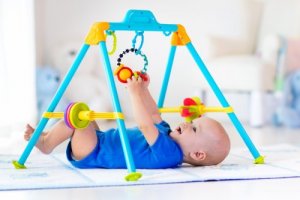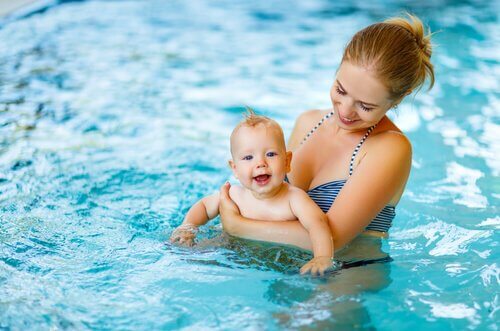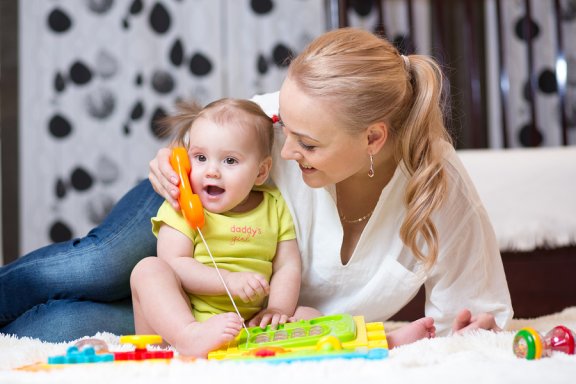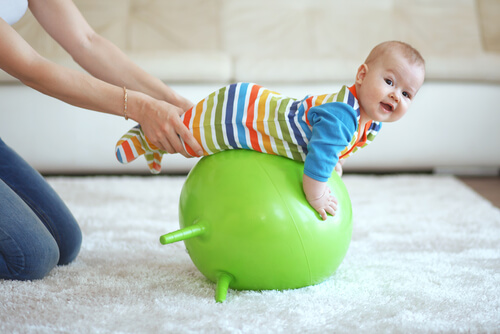7 Interesting Facts About Early Stimulation

Early stimulation helps children develop properly and faster. In addition to having an impact on their sensory awareness, these activities also have positive effects on their cognitive, social and motor skills. This is more than enough reason to take advantage of early stimulation during children’s first years of life.
“Every time a parent speaks to a young child, it sparks something in the child; it’s stimulation to the child. It forms brain connections.”
–Dr. Pia Rebello Britto–

Things to know before starting early stimulation
- Set the scene so there aren’t any unnecessary distractions. Turn off the TV, no music, no cellphones. Their surroundings influence their reactions to stimuli.
- Make sure your baby’s comfortable before you start the activities. For instance, change their diaper, feed them, make sure they slept well and dress them in comfortable clothes that allow them to move freely.
- Bring yourself to their level. The interaction between yourself and your baby is key to the success of the process.
- Establish an organized routine so their body and mind are aware of the stimuli. When it’s time to start, their curiosity will increase.
- It’s essential to work on their sensory perception. Our brains use this to develop plasticity and plenty of neural connections, which are necessary for acquiring new abilities and skills.
- Early stimulation needs to include affection. A child who is well cared for and is given attention and love, will become a healthy and emotionally-balanced adult with good social skills.
- Children have a natural willingness to learn, from the minute they’re born. They can establish long-lasting neural connections during the first three years of their lives.

How to begin early stimulation
Displays of affection, songs, talks, physical contact and suggesting imitation are essential strategies to help your child become willing to learn.
- Give your baby a massage. The touch of a mother’s hands works wonders in a child. It’s a connection and a language between the two of you. It also stimulates their immunological system, their muscle development, and growth hormones.
- Read books with pictures. When you read them stories, make sure to properly articulate and let them see how you pronounce words. Likewise, as they learn to speak, ask them literal questions, and then hypothetical, about the story.
- Exercise their memory. To the little ones, show them an object, hide it, and ask them to find it. Later on, you can make this harder by helping them memorize several images, words, or sounds.
- Talk to them, sing them songs. An essential part of early stimulation is language development. To work on this, talk to your baby, all of the time. Name things, imitate sounds, teach them rhymes and songs. Articulate words in an exaggerated manner so they can imitate your mouth’s movements.
- Play didactic games with them. Having fun with a purpose is great to encourage your baby’s capabilities and abilities. Nowadays, it’s easier to find games with an educational value.
- Be aware of their physical activity. From the moment they’re born, you need to help your baby exercise. Not only will this make them stronger, but it also encourages new and stronger neural connections.

Last, but not least…
Now you understand the importance of early stimulation for your baby’s childhood and adulthood. During their first years of life, you can teach them skills they’ll keep forever. They’ll become more productive and capable adults. So, what are you waiting for?
Early stimulation helps children develop properly and faster. In addition to having an impact on their sensory awareness, these activities also have positive effects on their cognitive, social and motor skills. This is more than enough reason to take advantage of early stimulation during children’s first years of life.
“Every time a parent speaks to a young child, it sparks something in the child; it’s stimulation to the child. It forms brain connections.”
–Dr. Pia Rebello Britto–

Things to know before starting early stimulation
- Set the scene so there aren’t any unnecessary distractions. Turn off the TV, no music, no cellphones. Their surroundings influence their reactions to stimuli.
- Make sure your baby’s comfortable before you start the activities. For instance, change their diaper, feed them, make sure they slept well and dress them in comfortable clothes that allow them to move freely.
- Bring yourself to their level. The interaction between yourself and your baby is key to the success of the process.
- Establish an organized routine so their body and mind are aware of the stimuli. When it’s time to start, their curiosity will increase.
- It’s essential to work on their sensory perception. Our brains use this to develop plasticity and plenty of neural connections, which are necessary for acquiring new abilities and skills.
- Early stimulation needs to include affection. A child who is well cared for and is given attention and love, will become a healthy and emotionally-balanced adult with good social skills.
- Children have a natural willingness to learn, from the minute they’re born. They can establish long-lasting neural connections during the first three years of their lives.

How to begin early stimulation
Displays of affection, songs, talks, physical contact and suggesting imitation are essential strategies to help your child become willing to learn.
- Give your baby a massage. The touch of a mother’s hands works wonders in a child. It’s a connection and a language between the two of you. It also stimulates their immunological system, their muscle development, and growth hormones.
- Read books with pictures. When you read them stories, make sure to properly articulate and let them see how you pronounce words. Likewise, as they learn to speak, ask them literal questions, and then hypothetical, about the story.
- Exercise their memory. To the little ones, show them an object, hide it, and ask them to find it. Later on, you can make this harder by helping them memorize several images, words, or sounds.
- Talk to them, sing them songs. An essential part of early stimulation is language development. To work on this, talk to your baby, all of the time. Name things, imitate sounds, teach them rhymes and songs. Articulate words in an exaggerated manner so they can imitate your mouth’s movements.
- Play didactic games with them. Having fun with a purpose is great to encourage your baby’s capabilities and abilities. Nowadays, it’s easier to find games with an educational value.
- Be aware of their physical activity. From the moment they’re born, you need to help your baby exercise. Not only will this make them stronger, but it also encourages new and stronger neural connections.

Last, but not least…
Now you understand the importance of early stimulation for your baby’s childhood and adulthood. During their first years of life, you can teach them skills they’ll keep forever. They’ll become more productive and capable adults. So, what are you waiting for?
All cited sources were thoroughly reviewed by our team to ensure their quality, reliability, currency, and validity. The bibliography of this article was considered reliable and of academic or scientific accuracy.
- Cabrera, M.C. y Sánchez C. (1982). La estimulación precoz; un enfoque práctico. Editorial Siglo XXI: España.
- Dorance, S. y Matter, P. (2001). Juegos de estimulación para los más pequeños. Madrid: AKAL.
- Gallahue, D. (1982). Understanding motor development in children. New York: John Wiley and sons.
- Guerrero, A. M., & Primaria, I. Y. (n.d.). La estimulación temprana. https://archivos.csif.es/archivos/andalucia/ensenanza/revistas/csicsif/revista/pdf/Numero_14/AMALIA_MORENO_1.pdf
- Moreno, J. A. (1999). Motricidad infantil. Aprendizaje y desarrollo a través del juego. Murcia: Diego Marín.
- Moreno, J. A., & De Paula, L. (2006). Estimulación de los reflejos en el medio acuático. Revista Iberoamericana de Psicomotricidad y técnicas corporales, 6(2), 193-206. https://www.um.es/univefd/reflejos.pdf
- Ordoñez, M. y Tinajero, L. (2012). La importancia de la estimulación temprana en la etapa infantil. Madrid, 208-240.
This text is provided for informational purposes only and does not replace consultation with a professional. If in doubt, consult your specialist.








